One of the next steps after finishing the body of the cardigan is to use a sewing machine to sew two lines zig-zag stitches on either side of the middle stitch of each steek.
Use my sewing machine?
Can’t remember the last time it’s been used. Considering the pile of stuff that’s accumulated around it, I’m sure it hasn’t been used for a couple of years – maybe even since I took up knitting in earnest. Instead of clearing my sewing area, I started spinning and got so caught up that I didn’t stop until I filled two bobbins.

It’s that roving I pulled out of storage last month. It was purchased from Woolgatherings at the Black Sheep Gathering a few years ago. I love the colors but have been too intimidated to dive right in. Handling the colorful Kuani yarn has inspired me to give it a try. I’m hoping that splitting the roving lengthwise – one piece for each bobbin – will work out OK.
 Mid-week my sewing machine emerged from the clutter and I managed to sew the zig-zag stitches as the pattern mentions. I’m not sure if this is necessary. My past two FI patterns didn’t mention doing this, but I though I’d give it a try. Kauni doesn’t seem to be as “sticky” as the VY wool I used for the Firebirds cardigan and the Roscalie vest so it’s probably a good idea.
Mid-week my sewing machine emerged from the clutter and I managed to sew the zig-zag stitches as the pattern mentions. I’m not sure if this is necessary. My past two FI patterns didn’t mention doing this, but I though I’d give it a try. Kauni doesn’t seem to be as “sticky” as the VY wool I used for the Firebirds cardigan and the Roscalie vest so it’s probably a good idea.
After sewing the zig-zag stitches on each section of extra stitches (front, back and armholes), I grafted the shoulders together with a piece of orange yarn.

Next, I cut the extra stitches (steek) on the upper left side before picking up stitches for the left sleeve.
This time I came up with a quirky calculation to figure out how to pick up the stitches evenly.
1. Measure the row gauge from the start of the armhole to the shoulder. Turns out I’m getting 8.5 rounds per inch.
2. Since 8.5 is a fraction I doubled it to get 17. That is, 17 rows for every two inches.
3. The stitch gauge is 6 stitches to the inch so I doubled that to get 12 stitches for every two inches.
4. From the last two steps I now know my pick up rate – 12 stitches within every 17 rows.
5. After sifting through several number combinations to find a pattern that will match my rate of 12 stitches in 17 rows, I settled on the following.
Following the rows on the body, *pick up 2 sts in every row, skip 1 row, pick up 3 sts in every row, skip 1 row, pick up 2 sts in every row, skip 1 row, pick up 3 sts in every row, skip 1 row, pick up 2 sts in every row, skip 1 row*. Repeat from * to * until 114 stitches have been picked up around the armhole
By the way, there’s another online shop that will ship Kauni to North America. It’s Astrid’s Dutch Obessions and the website is in English. I haven’t ordered from her before so I can’t vouch for the service but I have seen her postings on Knitter’s Review under “Sales and Shop News”. I’m glad that there’s one more source out there for us on the other side of the pond.
Sorry that I have no review of Jean’s DVD. I finished watching it this weekend and started a post but couldn’t get back to the computer tonight to finish it. I should have it ready Wednesday.
Answers to comments:
Frances, I don’t consider myself a fast knitter, especially since I’m quick to rip out anything I don’t like. I might seem fast because I tend to work on one thing at a time and try to fit it into my schedule whenever possible.
KarenJo, I haven’t taken Peg McNair’s class but it sounds interesting. I’ll have to check into that. Thanks.

 I’m more pleased with the top and bottoms of the front bands. I used a crochet hook to chain stitch over the last stitch. They line up pretty well with the neck and bottom band but next time I might just try the technique that Margaret D. mentioned in the comments for my last post. Thanks Margaret.
I’m more pleased with the top and bottoms of the front bands. I used a crochet hook to chain stitch over the last stitch. They line up pretty well with the neck and bottom band but next time I might just try the technique that Margaret D. mentioned in the comments for my last post. Thanks Margaret.
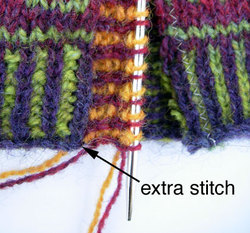

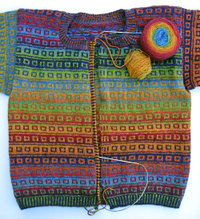 I really wanted to wrap up work on this cardigan before the Nihon Vogue program started last weekend but kept running into trouble with the buttonholes. My last and only encounter with
I really wanted to wrap up work on this cardigan before the Nihon Vogue program started last weekend but kept running into trouble with the buttonholes. My last and only encounter with 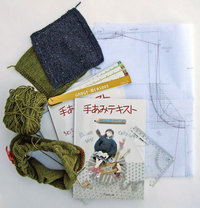

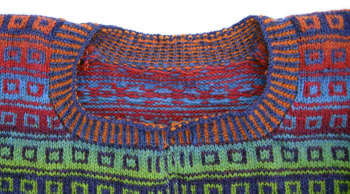

 Now it’s onto the collar.
Now it’s onto the collar. During my short break from the cardigan I started working on
During my short break from the cardigan I started working on 
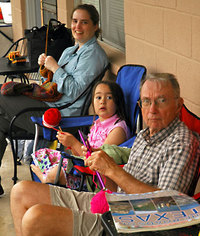 Last weekend was the family outing to the
Last weekend was the family outing to the 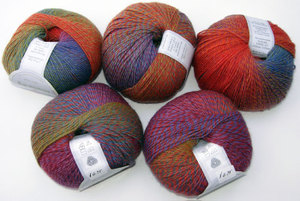
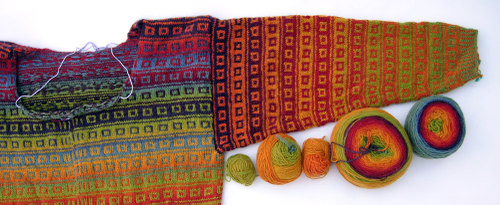

 Mid-week my sewing machine emerged from the clutter and I managed to sew the zig-zag stitches as the pattern mentions. I’m not sure if this is necessary. My past two FI patterns didn’t mention doing this, but I though I’d give it a try. Kauni doesn’t seem to be as “sticky” as the VY wool I used for the Firebirds cardigan and the Roscalie vest so it’s probably a good idea.
Mid-week my sewing machine emerged from the clutter and I managed to sew the zig-zag stitches as the pattern mentions. I’m not sure if this is necessary. My past two FI patterns didn’t mention doing this, but I though I’d give it a try. Kauni doesn’t seem to be as “sticky” as the VY wool I used for the Firebirds cardigan and the Roscalie vest so it’s probably a good idea.


You must be logged in to post a comment.